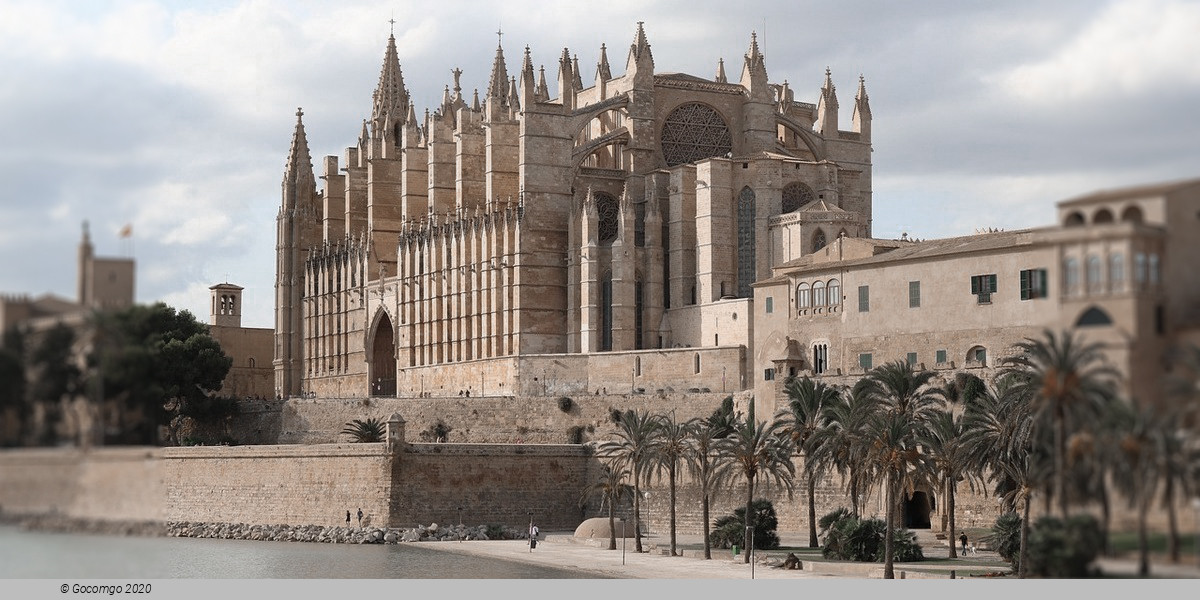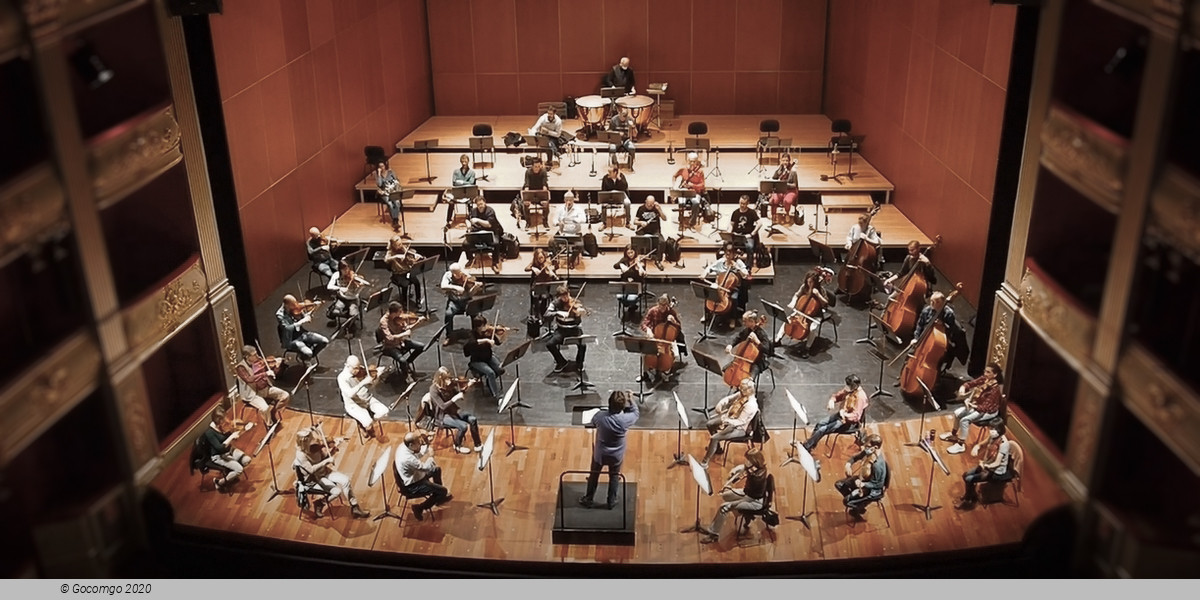Venues in Palma de Mallorca

Palma, unofficially known as Palma de Mallorca, is the capital and largest city of the autonomous community of the Balearic Islands in Spain. It is situated on the south coast of Mallorca on the Bay of Palma. The Cabrera Archipelago, though widely separated from Palma proper, is administratively considered part of the municipality.
History
Palma was founded as a Roman camp upon the remains of a Talaiotic settlement. The city was subjected to several Vandal raids during the fall of the Western Roman Empire, then reconquered by the Byzantine Empire, then colonized by the Moors (who called it Medina Mayurqa) and, in the 13th century, by James I of Aragon.
Roman period
After the conquest of Mallorca, the city was loosely incorporated into the province of Tarraconensis by 123 BC; the Romans founded two new cities: Palma on the south of the island, and Pollentia in the northeast – on the site of a Phoenician settlement. Whilst Pollentia acted as a port to Roman cities on the northwestern Mediterranean Sea, Palma was the port used for destinations in Africa, such as Carthage, and Hispania, such as Saguntum, Gades and Carthago Nova. Though present-day Palma has no significant remains from this period, occasional archaeological finds are made in city center excavations. For example, the remains of the Roman Wall can be seen at Can Bordils, the Municipal Archive, and below it, at the Maimó ben Faraig Center.
Byzantine period
Though the period between the fall of the Western Roman Empire and the Muslim conquest is not well understood (due to lack of documents), there is clear evidence of a Byzantine presence in the city, as indicated by mosaics found in the oldest parts of the Cathedral, which was in early medieval times part of a paleo-Christian temple.
Muslim period
Between 902 and 1229, the city was under Islamic control. It remained the capital of the island and it was known as Medina Mayurqa, which in Arabic means "City of Majorca".
Under the Emirate of Córdoba
The arrival of the Moors in the Balearic Islands occurred at the beginning of the 8th century. During this period, the population developed an economy based on self-sufficiency and piracy and even showed evidence of a relative hierarchy. The dominant groups took advantage of the Byzantine withdrawal due to Islamic expansion across the Mediterranean, to reinforce their domination upon the rest of the population, thus ensuring their power and the gradual abandonment of Imperial political structures.
In 707, a Muslim fleet, under the command of Abd Allah ibn Musa, son of the governor of Ifriqiya, Musa ibn Nusayr, stopped off at the island. It appears that Abd Allah convinced the powers of the city to accept a peace treaty. This treaty was granted in exchange for a tax, respect for social, economic and political structures to the communities that subscribed to it, as well as the continuity of their religious beliefs.
After 707, the city was inhabited by Christians who were nominally in allegiance to the sovereignty of the Umayyad Caliphate, yet who, de facto, enjoyed absolute autonomy. The city, being in Mallorca, constituted an enclave between western Christian and Islamic territories, and this attracted and encouraged increased levels of piracy in the surrounding waters. For wide sectors of the city's population, the sacking of ships (whether Muslim or Christian) which passed through Balearic waters was a source of riches over the next fifteen decades. Eventually, continued piracy in the region led to a retaliation by Al-Andalus which launched a naval fleet against the city and the whole of the Islands. The Islands were defended by the emperor Charlemagne in 799 from a Muslim pirate incursion.
In 848 (maybe 849), four years after the first Viking incursions had sacked the whole island, an attack from Córdoba forced the authorities to ratify the treaty to which the city had submitted in 707. As the city still occupied an eccentric position regarding the commerce network established by the Moors in the western Mediterranean, the enclave was not immediately incorporated into Al-Andalus.
While the Emirate of Córdoba reinforced its influence upon the Mediterranean, Al-Andalus increased its interest in the city. The consequence of this was the substitution of the submission treaty for the effective incorporation of the islands into the Islamic state. A squad under the command of Isam al-Jawlani took advantage of instability caused by several Viking incursions and disembarked in Mallorca, and after destroying any resistance, incorporated Mallorca, with Palma as its capital, to the Córdoban state.
The incorporation of the city into the Emirate set the basis for a new society. Commerce and manufacturing developed in a manner that was previously unknown. This caused considerable demographic growth, thereby establishing Medina Mayurqa as one of the major ports for trading goods in and out of the Emirate of Córdoba.
Dénia—Balearic taifa (1015–1087)
The Umayyad regime, despite its administrative centralization, mercenary army and struggle to gain wider social support, could neither harmonize the various ethnic groups inside al-Andalus nor dissolve the old tribes which still organized sporadic ethnic fighting. During the 11th century, the Caliphate's control waned considerably. Provinces broke free from the central Cordoban administration and became effectively sovereign states — taifas — under the same governors that had been named by the last Umayyad Caliphs. According to their origin, these "taifas" can be grouped under three broad categories: people of Arab, Berber or Slavic origin.
Palma was part of the taifa of Dénia. The founder of this state was a client of the Al-Mansur family, Muyahid ibn Yusuf ibn Ali, who could profit from the progressive crumbling of the Caliphate's superstructure to gain control over the province of Dénia. Subsequently, Muyahid organized a campaign throughout the Balearic Islands to consolidate the district and incorporated it into their "taifa" in early 1015.
During the following years, Palma became the main port from where attacks on Christian vessels and coasts could be launched. Palma was the base from where a campaign against Sardinia was launched between 1016 and 1017, which caused the Pisans and Genoese forces to intervene. Later, this intervention set the basis for Italian mercantile penetration of the city.
The Denian dominion lasted until 1087, a period during which the city, as well as the rest of the islands, was relatively peaceful. Their supremacy at sea was still not rivaled by the Italian merchant republics, thus there were few external threats.
Balearic Taifa (1087–1115) and Western Mediterranean
The Banu Hud conquest of Dénia and its incorporation to the Eastern district of the taifa of Zaragoza meant the destruction of the legacy of Muyahid. The islands were freed from mainland dominion and briefly enjoyed independence, during which Medina Mayurqa was the capital.
The economy during this period depended on both agriculture and piracy. In the latter 11th century, Christian commercial powers took the initiative at sea against the Muslims. After centuries of fighting defensively in the face of Islamic pressure, Italians, Catalans and Occitans took offensive action. Consequently, the benefits of piracy diminished causing severe economic stress on the city.
The clearest proof of the new ruling relation of forces, from 1090, is the Crusade organized by the most important mercantile cities of the Christian states against the Islands. This effort was destined to finally eradicate Muslim piracy mainly based in Palma and surrounding havens. In 1115, Palma was sacked and later abandoned by an expedition commanded by Ramon Berenguer III the Great, count of Barcelona and Provence, which was composed of Catalans, Pisans and other Italians, and soldiers from Provence, Corsica, and Sardinia, in a struggle to end Almoravid control.
After this, the Islands became part of the Almoravid dynasty. The involvement of all the taifa to a larger state helped to re-establish a balance along the frontier that separated western Christian states from the Muslim world.
Period of the Banu Ganiya (1157–1203)
The situation changed in the mid-12th century when the Almoravids were displaced from al-Andalus and western Maghreb by the Almohad. Almoravid dominions, from 1157 on, were restricted to the Balearic Islands, with Palma again acting as the capital, governed by Muhammad ibn Ganiya. The massive arrival of al-Andalus refugees contributed to reinforce the positions of the last Almoravid legitimatists, the Banu Ganiya, who, conscious of their weakness in the Western Mediterranean context, started to get closer to the growing powers represented by Italian maritime republics. Genoa and Pisans obtained in this period their first commercial concessions in the city and the rest of the islands.
The Banu Ganiya, taking advantage of the great loss suffered by Abu Yuqub Yusuf in the Siege of Santarém, attacked Ifriqiya, where the Almohad dominion had not been consolidated yet, in the same year. However, this attack was repelled and the Almohad authorities encouraged anti-Almoravid revolts in the Islands. The city was captured by the Almohads in 1203.
Christian reconquest and late Middle Ages
On 31 December 1229, after three months of siege, the city was reconquered by James I of Aragon and was renamed Ciutat de Mallorca (Mallorca City). In addition to being kept as the capital of the Kingdom of Majorca, it was given a municipality that comprised the whole island. The governing arm was the University of the City and Kingdom of Majorca.
After the death of James I of Aragon, Palma became the joint capital of the Kingdom of Majorca, together with Perpignan. His son, James II of Majorca, championed the construction of statues and monuments in the city: Bellver Castle, the churches of St. Francesc and St. Domingo, reformed the Palace of Almudaina and began the construction of the Cathedral of Majorca.
In 1391, anti-Jewish riots broke out. The Jewish community of Inca was completely wiped out, as were those of Sóller, Sineu, and Alcudia. In spite of the governor's prohibition on leaving the island, many Jews fled to North Africa. The remaining Jews were forced to convert under the threat of death.
Abraham Cresques was a 14th-century Jewish cartographer of the Majorcan cartographic school from Palma; Cresques is credited with the authorship of the famous Catalan Atlas.
The river that cut through the city gave rise to two distinct areas within the city; the "Upper Town" and "Lower town", depending upon which side of the river one was situated.
The city's advantageous geographical location allowed it extensive commerce with Catalonia, Valencia, Provence, the Maghreb, the Italian republics and the dominions of the Great Turk, which heralded a golden age for the city.
At the beginning of the 16th century, the Rebellion of the Brotherhoods (a peasant uprising against Charles V's administration) and the frequent attack of Turkish and Berber pirates caused a reduction of commercial activities and a huge inversion in defensive structures. As a consequence, the city entered a period of decadence that would last till the end of the 17th century.
17th to 19th centuries
The 17th century was characterized by the division of the city into two sides or gangs, named Canamunts and Canavalls (from Majorcan Catalan "the ones from the upper/lower side"), with severe social and economic repercussions. During this period, the port became a haven for pirates. During the last quarter of the century, the Inquisition continued its persecution of the city's Jews, locally called xuetes.
The fall of Barcelona in 1714 meant the end of the War of the Spanish Succession and the defeat and destruction of the Crown of Aragon, and this was reflected on the Nueva Planta decrees, issued by Philip V of Spain in 1715. These occupation decrees changed the government of the island and separated it from the municipality's government of Palma, which became the official city name. By the end of the 19th century, the name Palma de Mallorca was generalized in written Spanish, although it is still colloquially named Ciutat ("city") in Catalan. In the 18th century, Charles III of Spain removed interdiction of commerce with Spanish colonies in America and the port and commercial activity of the city grew once again.
At the beginning of the 19th century, Palma became a refuge for many who had exiled themselves from the Napoleonic occupation of Catalonia and Valencia; during this period freedom flourished, until the absolutist restoration. With the establishment of a contemporary Spanish state administrative organization, Palma became the capital of the new Balearic Islands province in the 1833 territorial division of Spain. The French occupation of Algeria in the 19th century ended the fear of Maghrebi attacks in Majorca, which favored the expansion of new maritime routes, and consequently, the economic growth of the city.
Modern period
The boom in tourism has caused Palma to grow significantly. In 1960, Mallorca received 500,000 visitors, in 1997 it received more than 6,739,700. In 2001 more than 19,200,000 people passed through Son Sant Joan airport near Palma, with an additional 1.5 million coming by sea. Since the advent of mass tourism in the 1950s, the city has been transformed into a tourist destination and has attracted many workers from mainland Spain. This has contributed to a huge change in the city's traditions, its language, and its economic power.
In the 21st century, urban redevelopment, by the so-called Pla Mirall (English "Mirror Plan"), had attracted groups of immigrant workers from outside the European Union, especially from Africa and South America.
More than half of the population works in tourism, approximately 80%, therefore being the main economic portal of Palma. Tourism has affected the rapid economic growth of Palma, making the island of Mallorca wealthier compared to other regions in Spain.
The second economic portal of Palma is agriculture. The main exports of Palma's agriculture are almonds, oranges, lemons and olives. The island is also gifted with a wide variety of natural resources, such as mines of copper, lead and marble.
The city also has several surrounding neighborhood communities including Establiments, Nord, Son Espanyol, Ces Cases Noves, and Sa Creu Vermella.



